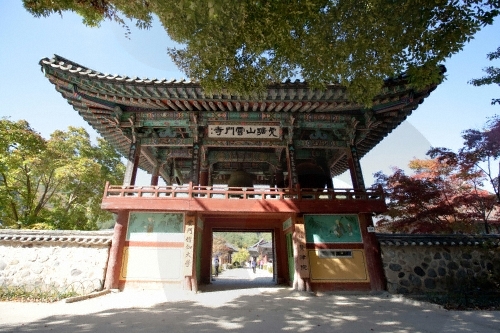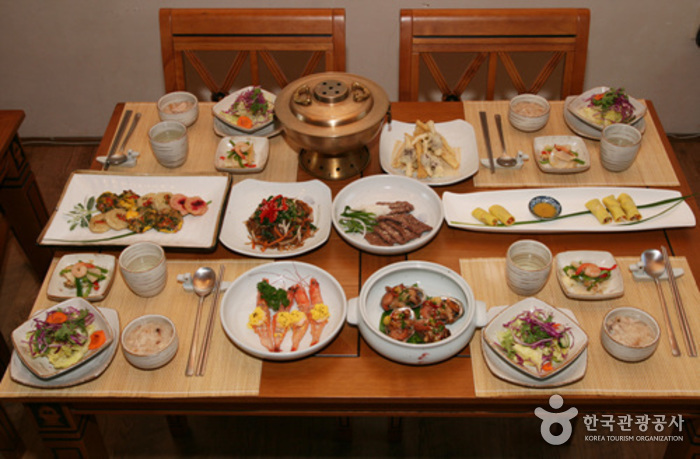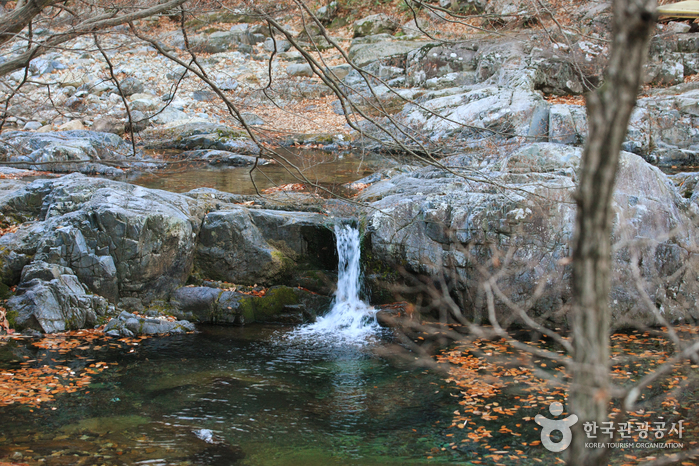Jogeummaru (조금마루)
14.2 Km 12 2024-02-20
9 Seosangpyeonggangbyeon-gil, Samnam-eup, Ulju-gun, Ulsan
Jogeummaru is a duck specialty restaurant that exclusively utilizes domestically-raised ducks in its culinary creations. The ducks are raised with sulfur, contributing to a clean and rich flavor profile, free from undesirable odors. The signature menu features ori yangnyeom bulgogi (duck bulgogi), ori tang (duck soup), and ori sutbul gui (charcoal-grilled duck). Ori yangnyeom bulgogi entails duck marinated in a spicy seasoning, grilled on a pan with added chives. Ori tang is a meticulously prepared broth cooked for 12 hours, incorporating various vegetables. Additionally, eomnamu ori baeksuk (whole duck soup with castor aralia) offers a unique dish where duck is boiled with medicinal herbs.
Unmunsa Temple (운문사)
14.2 Km 17414 2021-07-21
264, Unmunsa-gil, Unmun-myeon, Cheongdo-gun, Gyeongsangbuk-do
+82-54-372-8800
Unmunsa Temple in Cheongdo, Gyeongsangbuk-do belongs to Cheongdo-gun in terms of administrative district. However, it is actually more closely connected to Daegu in terms of traffic and lifestyle. Unmunsa Temple was built in 560 during the Silla period. This ancient temple features seven treasured artifacts including the Weeping Pine Tree (Natural Monument No. 180) and stone lantern. There are four small hermitages (Sariam, Naewonam, Bukdaeam and Cheongsinam) around the temple. Moreover, the surrounding forest of pine and fir trees only enhances the temple’s beauty.
Unmunsa is the largest Buddhist nunnery in Korea, maintaining a capacity of roughly 260 bhikkhunis, or Buddhist nuns, who practice Buddhism in a four-year term. But, thanks to its magnificence and lush forest, Unmunsan Mountain, located on the southernmost part of Taebaek Mountain range, has become a favorite spot for many tourists.
Galbi Gurakbu (갈비구락부)
14.3 Km 21073 2024-02-20
34-12 Namsangpyeong 2-gil, Samnam-eup, Ulju-gun, Ulsan
Galbi Gurakbu specializes in Eonyang bulgogi (Eonyang-style bulgogi), exclusively using the highest-grade female Korean beef. Eonyang bulgogi involves finely minced beef, generously seasoned, and grilled wide and flat on a gridiron. The mild seasoning ensures a pleasant texture without being overly stimulating. The restaurant boasts other excellent dishes, including siraegi doenjang jjigae (dried radish leaf soybean paste jjigae), so deungsim gui (grilled beef sirloin), yukhoe (beef tartare), and sogalbisal (grilled boneless galbi). Conveniently located, just a 5-minute taxi ride from KTX Ulsan Station.
Dodong Sanbang (도동산방)
14.4 Km 8210 2019-02-12
133, Songnakgol-gil, Ulju-gun, Ulsan
82-52-254-7076
Dodong Sanbang is a restaurant with five separate traditional Korean buildings situated on a large plot of land. It serves great traditional Korean set meals, and has a separate tea room where customers can enjoy a cup of tea after dining. Excluding winter, the restaurant offers a special program called “tteok mechigi” (rice cake pounding) where customers are invited to pound (or make) a rice cake with a mallet and eat it. The restaurant also includes a traditional souvenir shop and rice cake shop, and offers cultural programs.
Eonyang Jinmi Bulgogi (언양진미불고기)
14.5 Km 11 2024-02-20
33 Jungpyeong-ro, Samnam-eup, Ulju-gun, Ulsan
Eonyang Jinmi Bulgogi specializes in using Korean beef to create tender and flavorful Jinmi Bulgogi, where the natural taste of the ingredients is preserved. The signature dish features fresh beef topped with plenty of minced garlic, grilled to perfection over charcoal. The rich and well-presented side dishes, including yukhoe (beef tartare), complement the main dish and enhance the overall dining experience. The unique aspect of Eonyang Jinmi Bulgogi is the enjoyment of the dish without broth, grilling the meat on the grid and savoring it with green onion threads.
Eonyang Giwajip Bulgogi (언양기와집불고기)
14.8 Km 13 2024-02-20
86 Heonnyang-gil, Eonyang-eup, Ulju-gun, Ulsan
Eonyang Giwajip Bulgogi is a more than 40-year-old establishment housed in a renovated hanok with a history exceeding 100 years. Eonyang bulgogi is crafted by finely mincing beef, seasoning it with various spices, and grilling it on charcoal until it becomes wide and flat. The use of a gridiron for grilling imparts a distinct smoky flavor, and the mild seasoning contributes to a pleasant texture. When wrapped in fresh vegetables alongside pajeori (green onions), the combination produces an outstanding taste. The doenjang jjigae (soybean paste jjigae) and side dishes, known for their subtle seasoning, offer a clean and refreshing taste.
Wondong Recreational Forest (원동자연휴양림)
15.1 Km 174466 2024-02-23
69 Neulbat-ro, Wondong-myeon, Yangsan-si, Gyeongsangnam-do
Wondong Recreational Forest is situated where Gajisan Mountain – often referred to as the Alps of Korea – meets Yeongchuksan Mountain. It is celebrated for its breathtaking landscape, which includes valleys, dense forests, and waterfalls. This forest provides an ideal setting for forest bathing, allowing visitors to immerse themselves in nature along the crystal-clear waters of the valley, surrounded by unique rock formations. Additionally, with the largest campground in Wondong, the Wondong Recreational Forest attracts numerous tourists seeking a serene camping experience amidst natural beauty.
Naewonsa Temple (Yangsan) (내원사(양산))
17.6 Km 27153 2024-02-23
207 Naewon-ro, Habuk-myeon, Yangsan-si, Gyeongsangnam-do
Naewonsa Temple, situated in Cheonseongsan National Park, is home to a monumental Buddha statue standing at 5.5 meters, crafted during the Silla dynasty. The temple complex features various structures, including Bogwangjeon and Geungnakjeon Halls, showcasing its captivating architectural style. Renowned for its picturesque mountain landscapes and as a popular destination for autumn foliage, the temple attracts numerous visitors every year.
Naewonsagyegok Valley (내원사계곡)
17.6 Km 71025 2021-02-18
207, Naewon-ro, Yangsan-si, Gyeongsangnam-do
+82-55-380-4826
Naewonsagyegok Valley is located just below Naewonsa Temple at the foot of Cheonseongsan Mountain. The valley is surrounded by Jeongjoksan Mountain to the northeast, Wonjeoksan Mountain to the south, and Cheonseongsan Mountain to the southeast. The water running through the numerous valleys between these mountains has formed streams like Yongyeoncheon and Sangnicheon, which form the Yangsancheon Stream out of Naewonsagyegok Valley.
Naewonsagyegok Valley was formerly called Sogeumgang (little Geumgang), meaning that its beautiful scenery is comparable to that of the breathtaking Geumgangsan Mountain. It is also known as the “mystical valley” as crystal clear water flows all year round. The word “Sogeumgang” is distinctly engraved on one side of the cliff and large rocks stand in layers throughout the valley. Some of the rocks are called Byeongpungbawi Rock, literally meaning folding screen rocks, as they are stretched out much like folding screens.
The valley and the surrounding mountains are a popular summer vacation spot and a well-known hiking destination during the spring, fall, and winter. Muk (acorn jelly) made with acorns gathered from this area not only tastes great, but is also very healthy. Nearby attractions include Tongdosa Temple and Hongnyongpokpo Falls.
* Entrance into the upper region of Naewonsagyegok Valley is restricted.
Milyang189 (밀양189)
17.7 Km 0 2024-02-23
188-1 Yongpyeong-dong, Miryang-si, Gyeongsangnam-do
Milyang 189 is a spacious café situated near the Miryanggang River. Its interior, adorned with antique furniture and accessories, creates a charming European ambiance. The almond latte takes center stage as the signature menu item, complemented by other offerings such as einspänner and yeonyu latte (condensed milk latte). Visitors can relish the expertise of a professional barista, ensuring a delightful coffee experience with beans roasted to perfection.




 English
English
 한국어
한국어 日本語
日本語 中文(简体)
中文(简体) Deutsch
Deutsch Français
Français Español
Español Русский
Русский